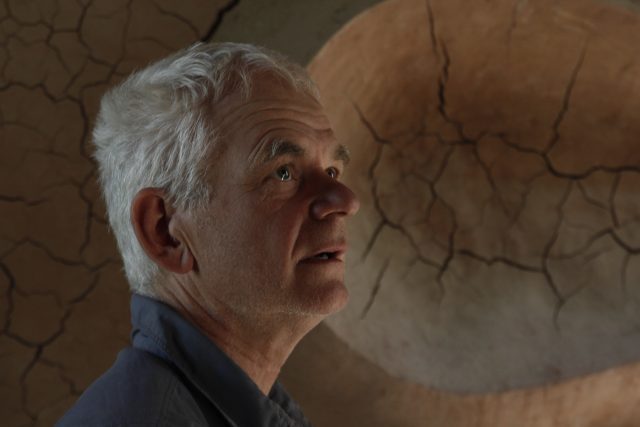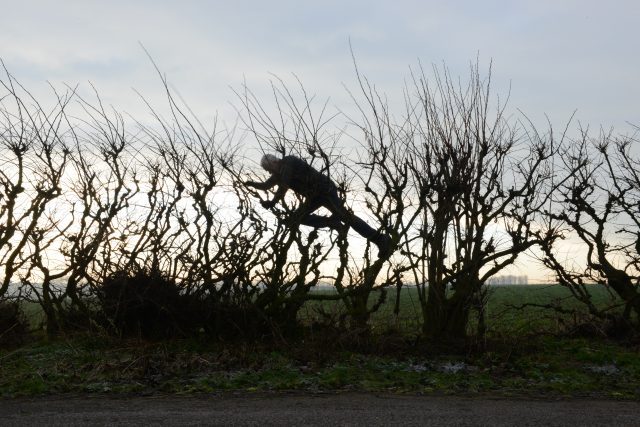
British artist Andy Goldsworthy marvels at the planet’s endless natural wonders in Leaning into the Wind (photo © Thomas Riedelsheimer, all rights reserved)
LEANING INTO THE WIND — ANDY GOLDSWORTHY (Thomas Riedelsheimer, 2016)
Film Forum
209 West Houston St.
Opens Friday, March 9
212-727-8110
filmforum.org
www.leaningintothewind.com
 Thomas Riedelsheimer follows up Rivers and Tides, his 2001 documentary about British artist Andy Goldsworthy, with Leaning into the Wind — Andy Goldsworthy, another fascinating journey with the peripatetic sculptor who uses the world as his canvas, Earth’s natural treasures as his materials. Goldsworthy finds simple pleasures in a beam of light in a cave, a tree fresh with ripe avocados, and walking barefoot on a homemade clay floor. Just as rain starts, he lies down on the street and lets the water pour over him; after a moment, he gets up, leaving a fading, dry outline of his body behind. He plucks leaves and lines them up an outdoor staircase until they form a lovely colored strip that passersby observe as if telling them which way to go. He carves out human shapes in stone to form chambers people can lie in. He has an “intense relationship” with the color yellow. He operates a jackhammer in a quarry. He works with flower petals, mud, twigs, fallen trees, huge rocks — basically, whatever he encounters on his travels can become part of his oeuvre. “I’m still just trying to make sense of the world,” he says. He is like a kid in a candy store as he takes a difficult path among a row of not-too-sturdy bushes or marvels at ants making their way across a forest passage, climbs trees in order to cast a shadow on the grass, and trudges through a stream to get to a favorite log. Many of his spur-of-the-moment works are temporary, to be seen only by himself and his assistant, his daughter Holly, unless captured on film, although plenty of art institutions do hold his work: His Garden of Stones is on permanent view at the Museum of Jewish Heritage in New York City. Through it all, he rarely laughs or even smiles; he’s rather serious, concerned about the impermanence of all living things. In one moving scene, he decides not to cut into a mountaintop for fear of upsetting its balance and beauty.
Thomas Riedelsheimer follows up Rivers and Tides, his 2001 documentary about British artist Andy Goldsworthy, with Leaning into the Wind — Andy Goldsworthy, another fascinating journey with the peripatetic sculptor who uses the world as his canvas, Earth’s natural treasures as his materials. Goldsworthy finds simple pleasures in a beam of light in a cave, a tree fresh with ripe avocados, and walking barefoot on a homemade clay floor. Just as rain starts, he lies down on the street and lets the water pour over him; after a moment, he gets up, leaving a fading, dry outline of his body behind. He plucks leaves and lines them up an outdoor staircase until they form a lovely colored strip that passersby observe as if telling them which way to go. He carves out human shapes in stone to form chambers people can lie in. He has an “intense relationship” with the color yellow. He operates a jackhammer in a quarry. He works with flower petals, mud, twigs, fallen trees, huge rocks — basically, whatever he encounters on his travels can become part of his oeuvre. “I’m still just trying to make sense of the world,” he says. He is like a kid in a candy store as he takes a difficult path among a row of not-too-sturdy bushes or marvels at ants making their way across a forest passage, climbs trees in order to cast a shadow on the grass, and trudges through a stream to get to a favorite log. Many of his spur-of-the-moment works are temporary, to be seen only by himself and his assistant, his daughter Holly, unless captured on film, although plenty of art institutions do hold his work: His Garden of Stones is on permanent view at the Museum of Jewish Heritage in New York City. Through it all, he rarely laughs or even smiles; he’s rather serious, concerned about the impermanence of all living things. In one moving scene, he decides not to cut into a mountaintop for fear of upsetting its balance and beauty.

Andy Goldsworthy follows an unusual path in Thomas Riedelsheimer’s documentary (photo © Thomas Riedelsheimer, all rights reserved)
Neither an interventionist nor a land artist, the sixty-one-year-old Goldsworthy, who worked on a farm as a teenager, is often at a loss for words when describing his art, hesitating, pausing, and not finishing sentences. “There are a lot of contradictions in what I make,” he says, struggling with his thoughts. “In a sense, I quite, uh, what am I trying to say? It’s a really difficult thing to explain.” He shares some details about himself — he’s been married twice and has five children, between the ages of four and twenty-seven — but he’d much rather talk about how we’re all part of nature and nature is part of us. Revisiting his university days in Morecambe, England, he stops by a trio of human-shaped chambers carved into the rock. “You feel the human presence here, and whether that’s death or life — I think it’s both, and I think that the chambers that I’ve made, for people to stand in, to lay in, are places to contain memory, the human presence, and that will inevitably address the ideas of death and the absence.” Cinematographer, editor, and director Riedelsheimer (The Colour of Yearning, Lhasa and the Spirit of Tibet), whose son, Felix, served as his assistant on the film, has to stay on his toes, never knowing which way Goldsworthy will go or what he will do when the urge hits him. At one point, the artist sneaks behind a bush in a city and shakes it as people walking by wonder what is going on; he then pops out as if nothing strange had just happened. The many lush images are accompanied by a gorgeous soundtrack by legendary composer and guitarist Fred Frith, who also scored Rivers and Tides. At the beginning of that film, Goldsworthy said, “Art for me is a form of nourishment. I need the land. I need it.” Sixteen years later, the land is still nourishing him, and Andy Goldsworthy is still nourishing us, showing us how to experience our natural environment in a whole new way.